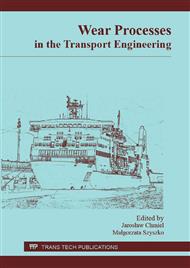[1]
P. Tyczewski, Analiza przyczyn uszkodzeń sprężarek chłodniczych, Logistyka, 3/(2011), s. 2871-2875.
Google Scholar
[2]
P. Tyczewski, Przykłady uszkodzeń sprężarek chłodniczych, Logistyka 03/(2012), s. 2333-2336.
Google Scholar
[3]
Why Compressors Fail Part 1 – Refrigerant Flood Back, Danfoss (2006).
Google Scholar
[4]
K. Górny, P. Tyczewski, W. Zwierzycki, Description of the experimental method and procedure of model wear test of refigeration compressors, parts, Solid State Phenomena Vol. 225 (2015) pp.85-92.
DOI: 10.4028/www.scientific.net/ssp.225.85
Google Scholar
[5]
A.Y. Suh, J.J. Patel, A.A. Polycarpou, T.F. Conry: Scuffing of cast iron and Al390-T6 materials used in compressor applications, Wear, 260(7-8), (2006), pp.735-744.
DOI: 10.1016/j.wear.2005.04.013
Google Scholar
[6]
J.D.B., De Melloa, R. Binderb, N.G., Demasc, A.A., Polycarpouc, Effect of the actual environment present in hermetic compressors on the tribological behaviour of a Si-rich multifunctional DLC coating, Wear 267 (2009) p.907–915.
DOI: 10.1016/j.wear.2008.12.070
Google Scholar
[7]
H.C. Sung: Tribological characteristics of various surface coatings for rotary compressor vane, Wear, 221(2), (1998), pp.77-85.
DOI: 10.1016/s0043-1648(98)00244-0
Google Scholar
[8]
Hong-Gyu Jeon, Se-Doo Oh, Young-Ze Lee: Friction and wear of the lubricated vane and roller materials in a carbon dioxide refrigerant, Wear, 267(5-8), (2009), pp.1252-1256.
DOI: 10.1016/j.wear.2008.12.097
Google Scholar
[9]
M.L. Cannaday, A.A. Polycarpou: Advantages of CO2 compared to R410a refrigerant of tribologically tested Aluminum 390-T6 surfaces, Tribology Letters, 21(3), (2006), pp.185-192.
DOI: 10.1007/s11249-005-9013-4
Google Scholar
[10]
N.G. Demas, A.A. Polycarpou: Tribological investigation of cast iron air-conditioning compressor surfaces in CO2 refrigerant, Tribology Letters, 22(3), (2006), pp.271-278.
DOI: 10.1007/s11249-006-9094-8
Google Scholar
[11]
N.P. Garland, M. Hadfield: Tribological analysis of hydrocarbon refrigerants applied to the hermetic compressor, Tribology International, 38(8), (2005), pp.732-739.
DOI: 10.1016/j.triboint.2004.10.009
Google Scholar
[12]
Y. Birol, F. Birol: Sliding wear behaviour of thixoformed AlSiCuFe alloys, Wear, 265(11-12), (2008), p.1902-(1908).
DOI: 10.1016/j.wear.2008.05.001
Google Scholar
[13]
P. Tyczewski, Brak oleju przyczyną uszkodzenia samochodowej sprężarki chłodniczej, Logistyka 3/(2014), s. 6458-6462.
Google Scholar
[14]
K. Górny, P. Tyczewski, W. Zwierzycki, Specification of lubricating oil operation in refrigeration compressors, Tribologia, 3/(2010), s. 63-73.
Google Scholar
[15]
J. Chmiel, R. Jasionowski, D. Zasada, Cavitation Erosion and Corrosion of Pearlitic Gray Cast Iron in Non-Standardized Cavitation Conditions, Solid State Phenomena Vol. 225 (2015) p.19 – 24.
DOI: 10.4028/www.scientific.net/ssp.225.19
Google Scholar
[16]
M. Dojcinovic, et al. The morphology of ductile cast iron surface damaged by cavitation, Metall. Mater. Eng. 18 (2012) 165–176.
Google Scholar
[17]
S. Hattori, T. Kitagawa, Analysis of cavitation erosion resistance of cast iron and nonferrous metals based on database and comparison with carbon steel data, Wear. 269 (2010) 443 – 448.
DOI: 10.1016/j.wear.2010.04.031
Google Scholar
[18]
Shen Cong; M.M. Khonsari, On the Magnitude of Cavitation Pressure of Steady-State Lubrication, Tribology Letters Vol: 51, Issue: 1, July (2013) p.153 – 160.
DOI: 10.1007/s11249-013-0158-2
Google Scholar
[19]
F.P. Grando, M. Priest, A.T. Prata, A two-phase flow approach to cavitation modelling in journal bearings, Tribology Letters, Vol: 21, Issue: 3, March (2006), p.233 – 244.
DOI: 10.1007/s11249-006-9027-6
Google Scholar
[20]
B. Bhushan, Introduction to Tribology, John Wiley & Sons, (2002).
Google Scholar
[21]
B.A. Gordeev, S.N. Okhulkov, et al. Long-term sealing loss of hydraulic bearings, Russian Engineering Research, Vol: 31, Issue: 7, July (2011), p.647 – 650.
DOI: 10.3103/s1068798x11070070
Google Scholar
[22]
K. Steller, On material sensitivity to the change of cavitation conditions, 6th Int. Conf. on Erosion by Liquid and Solid Impact ELSI VI, (1983), Paper 6.
Google Scholar
[23]
G.A. Schmitt, W. Buecken, R. Fanebust, Modeling microturbulences at surface imperfections as related to flow-induced localized corrosion, Corrosion. 48 (1992) 431–440.
DOI: 10.5006/1.3315957
Google Scholar
[24]
O.I. Balits'kyi, J. Chmiel, P. Krause, J. Niekrasz, M. Maciąg, The role of hydrogen in cavitation fracture of steel 45 in lubricants, Materials Science, nr 5/ (2009), pp.651-654.
DOI: 10.1007/s11003-010-9227-y
Google Scholar
[25]
J. Chmiel, E. Łunarska, Effect of cavitation on absorption and transport of hydrogen in iron. Solid State Phenomena, 183 (2012) pp.25-30.
DOI: 10.4028/www.scientific.net/ssp.183.25
Google Scholar
[26]
J. Chmiel, E. Łunarska, Role of Hydrogen in Cavitation Degradation of Iron in Water Solutions, Solid State Phenomena Vol. 225 (2015) p.59 – 64.
DOI: 10.4028/www.scientific.net/ssp.225.59
Google Scholar
[27]
E. Lunarska, O. Chernyayeva, Effect of the self-induced strain on the hydrogen permeation through Al, Intern. J. Hydrogen Energy, 31 (2006) 237-246.
DOI: 10.1016/j.ijhydene.2005.04.052
Google Scholar
[28]
J. O'M. Bockris, P.K. Subramanyan, Hydrogen embrittlement and hydrogen traps, J. Electrochem. Soc. 118 ( 1971) 1114-1121.
DOI: 10.1149/1.2408257
Google Scholar
[29]
M. Arora, C. -D. Ohl, K. Mørch, Cavitation Inception on Microparticles: A Self-Propelled Particle Accelerator, Phys. Rev. Lett. 92 (2004) 174501.
DOI: 10.1103/physrevlett.92.174501
Google Scholar
[30]
Hoon Choa Sung: Tribological characteristics of various surface coatings for rotary compressor vane, Wear, 221(2), 1998, s. 77-85.
DOI: 10.1016/s0043-1648(98)00244-0
Google Scholar


